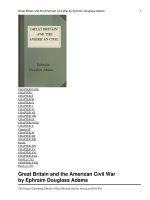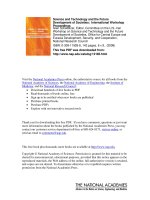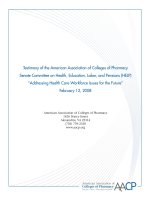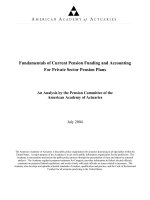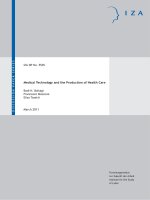Ethics technology and the american way of war jun 2007
Bạn đang xem bản rút gọn của tài liệu. Xem và tải ngay bản đầy đủ của tài liệu tại đây (1.24 MB, 187 trang )
E T H I C S , T E C H N O L O GY, A N D
T H E A M E R I C A N WAY O F WA R
Using four key case studies, this book examines the decisionmaking process
behind the American use of cruise missiles after the 1991 Gulf War. The author
argues that such precision strike technology loosens traditional constraints
on foreign intervention, such as fear of casualties, thereby making the use of
force more likely as an instrument of policy.
By comparing and contrasting the decisionmaking calculus in each of these
cases, the book concludes that the availability of precision strike weapons creates a “strategic window” in which the use of force becomes a plausible policy
choice. Thus, rather than the “pinprick” strikes that these episodes are often
characterized as, the author argues that the ability to use force in this manner
was an important policy option in a complex political environment and will
remain so in the future. This book investigates how the advent of precisionguided munitions affects the likelihood of US policymakers using force. As
such, it is an inquiry into the impact of ethics, strategy, and military technology on the decisionmaking of national leaders.
This book will be of much interest to students of US foreign policy, US
politics, military ethics, strategic studies, and international relations in general.
Reuben Brigety II is an Assistant Professor of Government and Politics at
George Mason University, and holds a PhD in International Affairs from
Cambridge University.
C O N T E M P O RA RY S E C U R I T Y S T U D I E S
Daniele Ganser, NATO’s Secret Armies: Operation Gladio and
Terrorism in Western Europe
Peter Kent Forster and Stephen J. Cimbala, The US, NATO and
Military Burden-Sharing
Irina Isakova, Russian Governance in the Twenty-First Century:
Geo-Strategy, Geopolitics and New Governance
Craig Gerrard, The Foreign Office and Finland 1938–1940:
Diplomatic Sideshow
Isabelle Duyvesteyn and Jan Angstrom (eds), Rethinking the Nature of War
Brendan O’Shea, Perception and Reality in the Modern Yugoslav
Conflict: Myth, Falsehood and Deceit 1991–1995
Tim Donais, The Political Economy of Peacebuilding in
Post-Dayton Bosnia
Peter H. Merkl, The Distracted Eagle: The Rift between America
and Old Europe
Jan Hallenberg and Håkan Karlsson (eds), The Iraq War: European
Perspectives on Politics, Strategy, and Operations
Richard L. Russell, Strategic Contest: Weapons Proliferation and
War in the Greater Middle East
David R. Willcox, Propaganda, the Press and Conflict: The Gulf War
and Kosovo
Bertel Heurlin and Sten Rynning (eds), Missile Defence: International,
Regional and National Implications
Chandra Lekha Sriram, Globalising Justice for Mass Atrocities:
A Revolution in Accountability
Joseph L. Soeters, Ethnic Conflict and Terrorism: The Origins and
Dynamics of Civil Wars
Brynjar Lia, Globalisation and the Future of Terrorism: Patterns
and Predictions
Stephen J. Cimbala, Nuclear Weapons and Strategy: The Evolution of
American Nuclear Policy
Owen L. Sirrs, Nasser and the Missile Age in the Middle East
Yee-Kuang Heng, War as Risk Management: Strategy and Conflict in an
Age of Globalised Risks
Jurgen Altmann, Military Nanotechnology: Potential Applications and
Preventive Arms Control
Eric R. Terzuolo, NATO and Weapons of Mass Destruction: Regional
Alliance, Global Threats
Pernille Rieker, Europeanisation of National Security Identity: The EU
and the Changing Security Identities of the Nordic States
T. David Mason and James D. Meernik (eds), International Conflict
Prevention and Peace-building: Sustaining the Peace in
Post Conflict Societies
Brian Rappert, Controlling the Weapons of War: Politics, Persuasion, and
the Prohibition of Inhumanity
Jan Hallenberg and Håkan Karlsson (eds), Changing Transatlantic
Security Relations: Do the US, the EU and Russia Form a New Strategic
Triangle?
Thomas M. Kane, Theoretical Roots of US Foreign Policy: Machiavelli
and American Unilateralism
Christopher Kinsey, Corporate Soldiers and International Security:
The Rise of Private Military Companies
Gordon Adams and Guy Ben-Ari, Transforming European Militaries:
Coalition Operations and the Technology Gap
Robert G. Patman (ed.), Globalization and Conflict: National Security
in a ‘New’ Strategic Era
James V. Arbuckle, Military Forces in 21st Century Peace Operations:
No Job for a Soldier?
Nick Ritchie and Paul Rogers, The Political Road to War with Iraq:
Bush, 9/11 and the Drive to Overthrow Saddam
Michael A. Innes (ed.), Bosnian Security after Dayton: New Perspectives
Andrew Priest, Kennedy, Johnson and NATO: Britain, America and the
Dynamics of Alliance, 1962–68
Denise Garcia, Small Arms and Security: New Emerging
International Norms
John Baylis and Jon Roper (eds), The United States and Europe:
Beyond the Neo-Conservative Divide?
Lionel Ponsard, Russia, NATO and Cooperative Security:
Bridging the Gap
Tom Bierstecker, Peter Spiro, Chandra Lekha Sriram and Veronica
Raffo (eds), International Law and International Relations: Bridging
Theory and Practice
James H. Lebovic, Deterring International Terrorism and Rogue States:
US National Security Policy after 9/11
John Dumbrell and David Ryan (eds), Vietnam in Iraq: Tactics, Lessons,
Legacies and Ghosts
Jan Angstrom and Isabelle Duyvesteyn (eds), Understanding Victory
and Defeat in Contemporary War
Scot Macdonald, Propaganda and Information Warfare in the
Twenty-first Century: Altered Images and Deception Operations
Derick W. Brinkerhoff (ed.), Governance in Post-Conflict Societies:
Rebuilding Fragile States
Adrian Hyde-Price, European Security in the Twenty-First Century:
The Challenge of Multipolarity
Reuben E. Brigety II, Ethics, Technology, and the American Way of War:
Cruise Missiles and US Security Policy
ETHICS,
T E C H N O L O GY, A N D
T H E A M E R I C A N WAY
O F WA R
Cruise Missiles and US Security Policy
Reuben E. Brigety II
First published 2007
by Routledge
2 Park Square, Milton Park, Abingdon, Oxon OX14 4RN
Simultaneously published in the USA and Canada
by Routledge
270 Madison Ave, New York, NY 10016
Routledge is an imprint of the Taylor & Francis Group,
an informa business
This edition published in the Taylor & Francis e-Library, 2007.
“To purchase your own copy of this or any of Taylor & Francis or Routledge’s
collection of thousands of eBooks please go to www.eBookstore.tandf.co.uk.”
© 2007 Reuben E. Brigety II
All rights reserved. No part of this book may be reprinted or
reproduced or utilised in any form or by any electronic, mechanical,
or other means, now known or hereafter invented, including
photocopying and recording, or in any information storage or retrieval
system, without permission in writing from the publishers.
British Library Cataloguing in Publication Data
A catalogue record for this book is available from the British Library
Library of Congress Cataloging in Publication Data
Brigety, Reuben E.
Ethics, technology, and the American way of war: cruise missiles and
US security policy/by Reuben E. Brigety II.
p. cm.
Includes bibliographical references and index.
ISBN 978-0-415-77064-4 (alk. paper)
1. United States – Military policy. 2. Tomahawk (Guided missile)
3. Limited war. 4. United States – Foreign relations – 1993-2001. 5.
United States – Military policy – Moral and ethical aspects. I. Title.
UA23.B7828 2007
172a.420973 – dc22
2006034567
ISBN 0-203-08892-1 Master e-book ISBN
ISBN10: 0-415-77064-5 (hbk)
ISBN10: 0-203-08892-1 (ebk)
ISBN13: 978-0-415-77064-4 (hbk)
ISBN13: 978-0-203-08892-0 (ebk)
F O R M Y FA M I LY
CONTENTS
Preface
Acknowledgments
Abbreviations
1
xi
xiii
xv
Introduction
1
PART I
Theoretical approaches
11
2
Humanity as a weapon of war
13
3
Limited war in American strategic thought
41
4
Tomahawk: History, technology, strategy
56
PART II
Practical applications
69
5
Operation Southern Watch – January 1993
71
6
Operation Bushwacker – June 1993
85
7
Operation Deliberate Force – August/September 1995
98
8
Operation Desert Strike – September 1996
113
9
Conclusion
129
Notes
Selected bibliography
136
153
ix
P R E FAC E
Everything flows and nothing stays . . . . You can’t step twice
into the same river.
Heraclitus, c. 540–480 BC
The world has changed dramatically since research for this book began in
October 1998. Although the Cold War had been over for close to a decade,
the United States and its allies were still struggling to construct a strategic
framework to guide their foreign policy. Initiatives such as the expansion of
NATO and the conduct of peacekeeping operations occupied the attention
of American and European strategists. Yet there seemed to be no clear, overarching theme that linked American foreign policy goals and the use of armed
force to achieve them.
That changed on 11 September 2001. On that day, four American commercial airplanes were hijacked within an hour of each other. Two of them
slammed into the twin towers of the World Trade Center in New York City, a
third crashed into one side of the Pentagon near Washington, and the fourth
crashed in a field in Pennsylvania. This coordinated terrorist attack on the soil
of the United States immediately focused American policymakers on the primary task of combating terrorism around the world. In a radio address to the
nation just a few days after the attacks, President George W. Bush remarked:
We are planning a broad and sustained campaign to secure our country
and eradicate the evil of terrorism. And we are determined to see this
conflict through. Americans of every faith and background are committed
to this goal.1
Precisely how this unprecedented assault on the United States fundamentally rearranges its alliances and priorities in global affairs is still emerging as of
this writing. Yet it is clear that it has undoubtedly caused American strategists
to reexamine how force is used to achieve foreign policy objectives. As soldiers and statesmen contemplate the efficacy of airpower after the 2001–2 war
in Afghanistan, and relearn the value of counterinsurgency operations in the
2003 war in Iraq, one of the doctrines which must also be reconsidered is the
role of limited war strategies enabled by precision weapons. The attacks of 11
September 2001 may have ushered in a period when the massive use of force
xi
P R E FAC E
in a campaign of total war was both an acceptable and a necessary response to
a mortal threat to the nation.
Not all crises, however, present a clear provocation with such an obvious
choice of response. So long as there are complex foreign policy dilemmas that
defy resolution through conventional diplomacy but resist the application of
overwhelming military power, it is vital to study the waging of limited war.
This book is an effort to understand the constraints that ethical considerations in the use of force present to policymakers and the role of technology
in overcoming them. Should it fulfill its purpose, it will contribute to the understanding of how the use of force can be more humane as it becomes more
effective as an instrument of statecraft.
Reuben E. Brigety II
Fairfax, Virginia, 2006
xii
AC K N O W L E D G M E N T S
While the writing of a book is a significant exercise for the author, it simply
cannot be completed without the assistance of many, many people. This was
certainly the case for me. I am profoundly grateful to a number of individuals
who made this work possible.
First and foremost, I would like to thank my doctoral adviser, Dr Paul
Cornish. His insightful analysis, constant encouragement, and complete confidence in this project were invaluable. I am, perhaps, even more grateful for
his warm friendship and for the thoughtfulness of his family. I will treasure
their kindness for the rest of my life.
It would have been impossible to conduct this research without the patience of some prominent people who consented to my interview requests
and who helped to guide my inquiries in their early stages. For their gracious
efforts, I am grateful to Adm. Dennis Blair (Ret.), Capt. Joseph Bouchard
(Ret.), Lt-Gen. Jim Clapper (Ret.), Mr Richard Clarke, Capt. Lee Geanuleas (Ret.), Adm. David Jeremiah (Ret.), Dr Anthony Lake, Rear-Adm. Tom
Marfiak (Ret.), Capt. Mike Martus (Ret.), Gen. Peter Pace, Mr Barry Pavel,
Gp-Capt. Stuart Peach, Mr Richard Pearle, Gen. Binford Peay (Ret.), Adm.
Leighton Smith (Ret.), Mr Hal Sonnenfelt, Mr Mark Talisman, and Dr Paul
Wolfowitz.
I would also like to express my gratitude to Sidney Sussex College of the
University of Cambridge. In particular, I would like to thank my graduate
tutors, Dr Daniel Tawfik and Dr Stuart Corbridge, and their secretary, Mrs
Anthea Ansell, for their professional and personal support. Dr Helen Castor,
Fellow of Medieval History, also played a pivotal role in my acceptance to
the International Studies program at Cambridge. She is a kind and gracious
friend.
For their financial support for my doctoral studies, I am extremely grateful
to the Cambridge Overseas Trust, the Sidney Sussex College North American
Trust and, most importantly, to the United States Naval Academy Alumni
Association for granting me the Thomas G. Pownall Scholarship, which made
possible the first two years of my studies at Cambridge. In particular, I would
like to thank Dr Mary Wintersgill for her exceptional administration of the
xiii
AC K N O W L E D G M E N T S
scholarship during the time of my candidacy and for her continued friendship.
I am especially grateful to the entire staff of the Centre of International
Studies at the University of Cambridge. It is difficult for me to imagine a
more enlightened, diverse, and engaging place to study international affairs,
or a more dedicated and caring staff to assist in that effort. Specifically, I am
grateful to Professor James Mayall for his exceptional past leadership of the
Centre; to Dr Philip Towle for first having faith in me as a candidate for the
Master’s Degree in international affairs; to Dr Geoffrey Edwards for his continuing interest in my academic and professional progress; to Mr Marc Weller
for his brilliant legal instruction and for his wise counsel; to Dr Yezid Sayigh
for showing me a new facet of the world of Middle Eastern politics and for his
steadfast friendship and kind good wishes as I have progressed in my studies;
and, finally, but certainly not least, to Mrs Ann Kemp and Mrs Wendy Cooke
for their unfailing administrative support and constant personal kindness.
I could not have persevered through the completion of this work without
the constant support of many family and friends. Although it is impossible to
name them all, I would like to thank some of them explicitly here: Peter Ackerman, Lt-Cdr Silas and Jacqueline Ahn, Dr Richard Betts, Dr Stephen Biddle,
Louis and Suzanne Blair, David Bonfili and Michelle Gavin, Cdr Richard Bryant, Lt-Cdr Hugh and Lt Rupa Danier, Jim Day, Sean and Jenifer Fahey, Louis
Font and Gail Glazer, Cdr Tim and Vicky Galpin (Ret.), Emily Goldblatt,
Matthew Goldin, Dr Louis Goodman, Dr Samantha Harvey, Tom Henneberg,
Dr Frances Harbour, Dr James Joyner IV, Dr Tricia Juhn, Rev. Albert and
Lucile Keller, Vice-Adm. Thomas and Lucy Kinnebrew (Ret.), Celeste Kruger,
John and Virginia Lawrence, Adm. Charles Larson (Ret.), Mike and Alexa
Mattis, Judge Stephan and Evelyn Mickle, Stephanie Mickle, Dr Charles and
Anne McIntosh, Dr Evan Medeiros, Dr Jamie Miller, Ruth Morgan, Choise
and Barabara Murray, Nicholas Patterson, Kendra Ryan, Sasha and Cori Sabet,
Lt-Cdr Steve and Lauren Shedd, Joshua Shultz and Shoma Haque, Gibran Van
Ert, Wyman and Rosemary Winbush, Dr Stephen and Alexandra Wrage, Sam
and Tracey Zager, and Joy Zarembka.
For their enduring love, support and encouragement, I am eternally grateful to my parents, Drs Reuben and Barbara Brigety.
To my beloved Leelie and our son Roebel, I love you both.
xiv
A B B R E V I AT I O N S
ABL
AFSOUTH
ALCM
BSA
CDC
CEB
CEP
CG
CIA
CINC
CINCSOUTH
COMAIRSOUTH
CJCS
CMSA
CMSALANT
CMSAPAC
CVN
DCI
DD
DDG
DOD
DSMAC
EC
FBI
GLCM
GPS
HARM
HDZ
ICBM
IIS
INF
IWG
JCS
armored box launcher
Allied Forces, Southern Europe
air-launched cruise missile
Bosnian Serb Army
Croat Democratic Community
combined effects bomblet
circular error probable
cruiser-guided missile
Central Intelligence Agency
commander-in-chief
Commander-in-Chief, Allied Forces, Southern Europe
Commander, Allied Air Forces, Southern Europe
Chairman, Joint Chiefs of Staff
cruise missile support activity
cruise missile support activity – Atlantic
cruise missile support activity – Pacific
aircraft carrier – nuclear propulsion
Director of Central Intelligence
destroyer
destroyer-guided missile
Department of Defense
digital scene matching area correlator
European Community
Federal Bureau of Investigation
ground-launched cruise missile
global positioning system
high-speed anti-radiation missile
Croat Democratic Union (English translation)
intercontinental ballistic missile
Iraqi Intelligence Service
intermediate nuclear forces
interagency working group
Joint Chiefs of Staff
xv
A B B R E V I AT I O N S
JNA
KDP
KPJ
LCY
MAD
MIT
MOU
MRASM
NAC
NATO
NCA
NIMA
NVA
NSC
OPEC
P-5
PCC
PKK
PGM
PUK
RMA
SACEUR
SAM
SEAD
SDA
SDS
SLCM
SSN
TASM
TERCOM
TEZ
TOT
TLAM
UK
UN
UNPROFOR
UNSC
UNSCOM
US
USCENTOM
USSR
VCJS
VLS
WMD
Yugoslav National Army (English translation)
Kurdish Democratic Party
Communist Party of Yugoslavia (English translation)
League of Communists of Yugoslavia
mutually assured destruction
Massachusetts Institute of Technology
memorandum of understanding
medium-range air-to-surface missile
North Atlantic Council
North Atlantic Treaty Organization
National Command Authority
National Imagery and Mapping Agency
North Vietnamese Army
National Security Council
Organization of Petroleum Exporting Countries
Permanent Five Members of the United Nations
Security Council
policy coordinating committee
Kurdistan Worker’s Party (English translation)
precision-guided munition
Patriotic Union of Kurdistan
revolution in military affairs
Supreme Allied Commander, Europe
surface-to-air missile
suppression of enemy air defenses
strategic decisionmaking apparatus
Serbian Democratic Party (English translation)
sea-launched cruise missile
attack submarine – nuclear propulsion
Tomahawk anti-ship missile
terrain contour matching
total exclusion zone
time over target
Tomahawk land attack missile
United Kingdom
United Nations
United Nations Protection Force
United Nations Security Council
United Nations Special Commission
United States
United States Central Command
Union of Soviet Socialist Republics
Vice-Chairman, Joint Chiefs of Staff
vertical launch system
weapon(s) of mass destruction
xvi
1
INTRODUCTION
Only the dead have seen the end of war.
Plato, 438–347 BC
Pin-prick . . . Limp response . . . Abject failure . . . . Such words have been used
repeatedly by various critics to describe the use of the Tomahawk cruise missile by American policymakers in dealing with foreign policy crises.1 Clearly,
the condemnation is not leveled at the weapon, per se – which has performed
brilliantly in combat – but at the strategy underlying its employment. The limited use of force, so the argument goes, directed against a determined enemy
and designed to minimize the loss of life on all sides is at best ineffectual and
at worst counterproductive. It ignores the central reality of war that both soldiers and civilians are often, and regrettably, killed. A nation must be prepared
to pay the price required in blood and treasure if it seeks to achieve its objectives through the force of arms. To presume otherwise, argue critics, is both
delusional thinking and a dangerous strategy that can embolden adversaries,
discourage allies and, ultimately, undermine the nation’s security. While the
Tomahawk may be a very useful weapon, its employment in anything short
of a broad military campaign or a decapitation attempt is a prescription for
defeat.
Regardless of the merits of such objections, they do not recognize a fundamental development. The use of the Tomahawk to achieve limited political
objectives is not the result of feckless decisionmakers ignorant of the true
demands of warfare in support of the national interest. Rather, it represents
a logical and innovative response to real constraints on the use of force that
come from changes in the international environment and shifting US domestic political considerations. Specifically, increased international attention on
the protection of civilians in armed conflict has elevated the incidence of socalled “collateral damage” from the status of a vexing moral dilemma to a serious strategic problem. Furthermore, the American experience with warfare
since World War II generally, and especially since the Vietnam War, has made
it politically difficult for senior decisionmakers to risk the lives of American
service personnel for anything but the most serious threats to American national security. As there continued to be provocations which fell short of this
threshold, yet required the use of force, it was necessary for policymakers to
develop approaches that made military power a viable instrument of statecraft
1
INTRODUCTION
despite concern for casualties among non-American civilians and US military
personnel. Through the use of new precision weapons technologies and established doctrines of limited war, policymakers not only found a means of
circumventing these constraints but eventually of turning them into assets
that could help advance America’s interests. In so doing, they have initiated an
emerging American approach to the use of force in which humanity is becoming a weapon of war.
The importance of international norms regarding civilian protections in
warfare began to strengthen after World War II. The codification of the 1949
Fourth Geneva Convention, and the subsequent 1977 Additional Protocols I
and II, explicitly forbade attacks on civilians as a method of war. Furthermore,
they stipulated that any incidental harm caused to civilians as a result of assaults on legitimate targets must be proportional to the direct military advantage gained from such attacks. Although Cold War politics and the inherent
weakness of international law made the enforcement of such norms difficult,
their articulation nevertheless established important principles that would
subsequently become the basis for their strategic salience in a post-Cold War
environment.
Chronologically coincident to the development of legal protections for
civilians in armed conflict was the growth of limited war doctrine in American
strategic thought. The atomic blasts at Hiroshima and Nagasaki had a profound impact beyond hastening an end to World War II. They also ushered in
a new era in the history of warfare, and indeed of geopolitics, marked by the
prospect of a catastrophic nuclear exchange between the United States and the
Soviet Union. As the arsenals of the superpowers grew, so did the possibility
that any use of conventional armed forces to counter a particular threat might
escalate into a full-fledged nuclear war. The notional Pyrrhic victory that
would result from such a conflict challenged the very assertion that a nuclear
war could be “winnable.” It also encouraged American strategists to consider
ways in which military power could be harnessed in the nuclear era to support
political objectives in a rational manner with acceptable costs. The result was a
body of thought dedicated to the concept of limited war. While some thinkers
considered the topic of limited nuclear war in which nuclear exchanges might
be graduated in scale and scope, others contemplated paradigms of limited
conventional war where non-nuclear forces could be used to achieve discreet
political objectives without triggering a nuclear response. Most of this work
embodied principles such as signaling, reprisal, and coercion, in which armed
force achieved political objectives by persuading an enemy to take a desired
action rather than eliminating its ability to resist, as dictated by Clausewitzian
models of total war.
Finally, advances in American cruise missile technology dramatically expanded the options available for the use of force. Experimentation with primitive forms of cruise missiles began even before the end of World War II as
the United States tried to develop weapons similar to the V-1 rockets that
2
INTRODUCTION
Germany used to terrorize Great Britain. Following the war, development
continued as the US Navy worked on sea-launched versions of cruise missiles and the US Air Force tested air-launched models. The guidance systems,
avionics, and warhead designs available to weapons engineers by the early
1960s made it difficult to design cruise missiles that were both practical and
effective in their tactical employment. Although the Air Force persisted in
pursuing the technology throughout this period (albeit at a relatively modest
pace), the Navy essentially abandoned its cruise missile program for a decade.
The Soviets, however, were able to develop sea-launched cruise missiles and
invested in them heavily as weapons for their surface fleet to counter American dominance with tactical aviation assets aboard aircraft carriers. When a
Soviet-made cruise missile sank an Israeli destroyer during the 1967 Six-Day
War, US Navy leaders recognized the utility of this weapon. Furthermore, a
series of technological advances by the early 1970s made it possible to conceive of a long-range cruise missile that could be accurate, lethal, and practical
to employ. Finally, the advent of high-level arms control negotiations between
the United States and the Soviet Union provided a political impetus to develop nuclear-armed cruise missiles as bargaining chips to encourage Soviet
concessions in other weapons categories. This combination of forces led the
US Navy to deploy its first multimission cruise missile by the early 1980s. It
was called the Tomahawk. With initial efforts focused on its development as
an anti-ship and tactical nuclear weapon, the creation of a conventional land
attack variant of Tomahawk was almost an afterthought. This is ironic as it is
only in the conventional land attack configuration that Tomahawk has been
used in combat. Still, the availability of manned aircraft armed with relatively
inexpensive conventional munitions led observers to question the cost-effectiveness, and ultimately the utility, of conventional Tomahawk strikes. Indeed,
noted authority Richard Betts suggested as early as 1981:
For cruise missiles with conventional armament, the primary conceptual
issue is whether or not they will provide new tactical options. The salient
question is cost-effectiveness . . . . But more than strategic and theater
nuclear forces, whose adequacy is assessed primarily in terms of deterrence theories with large political and psychological components, conventional cruise missile sufficiency depends on operational doctrine.2
The end of the Cold War provided the context in which the maturity of
American cruise missile technology was combined with an emergent operational doctrine designed to meet the challenges of a new era in international
affairs. The debut of the Tomahawk during the 1991 Persian Gulf War graphically demonstrated its power and promise. The unmanned weapon’s ability to
strike with unprecedented accuracy from great distances, and to minimize risks
to civilians and service personnel during combat, suggested a new way of applying force to achieve strategic objectives. It also began to raise expectations
3
INTRODUCTION
in the American body politic and in the international community about the
ability of the United States to wage war while avoiding harm to innocents.
These developments coincided with the strengthening of the humanitarian
and human rights movements that occurred after the demise of the competition between the superpowers. US President George H.W. Bush hailed this
historical milestone as the beginning of a New World Order in which nations
would engage in a “partnership whose goals [would be] to increase democracy,
increase prosperity, increase the peace, and reduce arms.”3 Although the collapse of the Soviet Union seemed to eliminate the prospect of a global nuclear
war, other intractable problems soon arose. Ethnic wars from the Balkans and
the Caucasus to the Great Lakes region and the Horn of Africa sorely tested
the vision of a peaceful and just new world.
Although they were often intense and destructive clashes killing thousands
of people, the arguable relevance of these conflicts to the United States was not
immediately obvious. For a nation disposed to resort to force only in support
of its national interests, using American military forces to achieve a solution to
these so-called “peripheral conflicts” was a suspect proposition. Nevertheless,
pressure for action often mounted. The killing of innocent civilians in distant
lands could be graphically delivered in real time to the living rooms of Western
European and American audiences by the new, instantaneous, global news media. As citizens demanded an end to the killing on the grounds of protecting
universal human rights, many also insisted that civilians be spared the brunt
of foreign military operations designed to protect them from the brutality of
forces within their own national borders. Christopher Coker used the term
“humane war” to describe post-modern efforts to wage war in a humanitarian manner in order to support humanist objectives.4 Others described it as
humanitarian intervention, and suggested that it was perverse to kill civilians,
even incidentally, in the course of combat operations initiated to protect them
from attack. Thus, it was important to design military campaigns of this type
in such a way that would spare harm to civilians as much as possible. Precision
munitions in general, and the Tomahawk cruise missile in particular, would be
indispensable in this regard.
Confronting ethic conflicts, however, was not the only challenge to the
United States in the post-Cold War world. Intransigent dictators such as Saddam Hussein and implacable non-state actors such as Al-Qaida provided recurrent provocations to the interests of America and its allies. Although many
argued throughout the 1990s that such threats constituted a profound danger,
both the domestic and the international political environment made it difficult
to respond to them with massive military force. President George H.W. Bush
made an explicit decision to end the 1991 Persian Gulf War without toppling
the Iraqi regime, opting instead to rely on economic and other sanctions to
contain it. This policy was continued by the Clinton administration, which
recognized that (even if it chose to) there was little international support for
4
INTRODUCTION
another war on Iraq. Regarding Al-Qaida, using armed force in a “total war”
paradigm against an armed, transnational terror organization was extremely
complicated militarily, legally, and diplomatically. Finally, American popular
resistance to risking the lives of American service personnel where the vital
national interest was at least debatable, if not in doubt, significantly limited
the strategic options available to senior decisionmakers.
Despite these myriad constraints, it was clear that the use of force would
still be required in the post-Cold War era. Complex contingencies that did not
present the United States with an obvious threat to its vital national interests
made it difficult to mobilize American public opinion in risking the lives of
American service personnel. Yet such crises often defied resolution through
conventional diplomacy. Thus, in case after case, the challenge confronting
American policymakers was to find a way to make the application of force
a viable option in such a way that protected civilians to the extent possible,
served US interests to the extent necessary, and limited risks to soldiers to the
extent avoidable.
The maturation of the Tomahawk, combined with established strategies of
limited war, allowed military force to be a viable instrument of statecraft in
this contested environment. In addition, the tactical success of these weapons
and the strategic flexibility that they provided to policymakers contributed
to the development of other precision-guided munitions and associated doctrines for their use. Ultimately, this trend, along with other developments in
US military practice, has led to a strategic approach in which the United States
has tried to demonstrate its benevolence to civilians in war zones where it is
conducting combat operations in a deliberate attempt to influence positively
international public opinion regarding both the ends and the means of its resort
to armed force. In addition to the wide use of precision munitions in limited
and total war scenarios, this trend is characterized by the combat delivery of
humanitarian assistance to civilians in war zones, post-conflict reconstruction
projects, and information campaigns designed to display America’s goodwill
to the local population in a theater of operation as well as to global audiences worldwide. Such initiatives represent an effort not merely to overcome
humanitarian constraints on the military instrument, but to turn them into a
strategic advantage. Hence, the United States is exhibiting a novel approach,
tailored to the realities of the prevailing circumstances, in which humanity
may be regarded as a weapon of war.
This book is an examination of the first four uses of the Tomahawk cruise
missile to achieved discrete and limited political objectives. Since the last of
these strikes in 1996, the United States has continued to use cruise missiles in
this manner. It launched limited strikes against targets in Iraq in August 1998,
as well as against targets in Sudan and Afghanistan in December 1998. It has
also employed Tomahawks and other precision munitions as part of broader
air campaigns during Operation Allied Force in the former Yugoslavia in 1999,
5
INTRODUCTION
Operation Enduring Freedom in Afghanistan in 2001, and in Operation Iraqi
Freedom in Iraq in 2003.
The object of this work is not simply the use of cruise missiles per se, but
the extent to which they permit policymakers to circumvent and co-opt
constraints on the use of force. As such, it focuses on decisions made at the
highest levels of the American government to understand the pressures that
senior officials face in confronting complex crises and the extent to which
long-range precision weapons systems provide additional options for action.
Thus, the tactical results of these strikes are of secondary importance to the
political decision to employ cruise missiles and the strategies underlying their
use. Such an analytical emphasis is intended to elucidate an emerging humanitarian approach in US military policy and to demonstrate why the Tomahawk
has become the “weapon of choice” for US presidents.
Plan for the book
This work is divided into two sections. Part I examines the theoretical, strategic, and technical bases for exploring the relevance of the Tomahawk in American military practice. Part II identifies the first four case studies of the use of
cruise missiles to support discrete foreign policy objectives since the end of
the Persian Gulf War when the conventional land attack Tomahawk was first
used in combat. Finally, these theoretical and practical bases will be used to
suggest implications for the use of precision-guided munitions in American
approaches to limited war and, more broadly, their place in a humanitarian
strategy for armed conflict.
Part I: Theoretical approaches
Chapter 2: Humanity as a weapon of war
Despite the historical record of death and destruction associated with it, warfare has always had restrictions. Indeed, it is the existence of such rules that
distinguish killing in war from murder in society. This chapter explores the
philosophical and theoretical bases for conceptions of moderation in armed
conflict. By examining warrior traditions, Christian just war philosophy, international humanitarian law, and international relations theory, it argues that
the norm of civilian protections in armed conflict is a powerful consideration
in the conduct of warfare. It has traditionally been seen as a limitation on
the freedom of action of belligerents in battle and, therefore, on their ability
to achieve victory. If the purpose of warfare is to serve political objectives,
then restrictions on combat operations designed to protect civilians may be
regarded as strategic constraints that impede the utility of armed force to support strategic objectives. Yet the chapter argues that humanitarian norms such
6
INTRODUCTION
as civilian protection can also serve as strategic enablers, the observance of
which can support the objectives for which a state uses force. There is a basis
for this humanitarian approach in American strategic culture, which helps to
explain an emerging trend in US military practice where humanity is a weapon
of war.
Chapter 3: Limited war in American strategic thought
Wars may be fought in many ways. They can be unlimited in their objectives
or means, or they may be deliberately limited in their scope, time, or purpose.
This chapter explores the development of limited war approaches in modern
American strategic theory. Originally conceived under the cloud of nuclear
war, early limited war strategies offered methods of calibrating the use of conventional and nuclear force in order to make military power a viable instrument of statecraft without triggering a global nuclear exchange with the Soviet
Union. By tracing the evolution of this thinking from its origins in the Cold
War to its continued relevance in the post-Cold War world, this chapter describes the strategic framework in which cruise missiles are used to achieve
limited objectives through the use of force.
Chapter 4: Tomahawk: history, technology, and strategy
America is nothing if not a technological superpower. Chapter 3 traces the
history of the Tomahawk cruise missile, taking note of the political and institutional forces that drove its development. It explains in detail, through
unclassified sources, the technical capabilities embodied in the Tomahawk and
why the technology present in the weapon has truly revolutionary strategic
significance. Its twin characteristics of very high precision and “stand-off ”
launching several hundred miles away from its target allow each Tomahawk
missile to deliver a significant amount of conventional explosives without
immediately endangering the lives of American personnel, while (in theory)
minimizing the casualties caused by an attack.
Part II: Practical applications
Chapter 5: Operation Southern Watch (January 1993)
This is the first instance of cruise missiles being used since the 1991 Persian
Gulf War and their first use to influence discrete political events. Launched
in the final days of the first Bush Administration, Operation Southern Watch
used cruise missiles to influence Iraqi compliance with the United Nations
weapons inspection regime. The decision to employ the weapon and the weapon’s effectiveness in achieving the desired political result are discussed.
7
INTRODUCTION
Chapter 6: Operation Bushwacker (June 1993)
Operation Bushwacker (June 1993) was the first use of force by the Clinton
administration. A purely punitive raid, it was launched to retaliate against an
alleged assassination plot against former President George H.W. Bush by Iraqi
Intelligence Service agents. The motives of the strikes, the method by which
the administration made the decision, and the immediate aftermath of the attack are all treated in this chapter.
Chapter 7: Operation Deliberate Force (September 1995)
Cruise missiles were employed against Serbian positions in Bosnia as a part
of the larger NATO Operation Deliberate Force. The use of force in this instance was a classic case of “coercive diplomacy,” yet the role of Tomahawk in
this effort was relatively small. The operation was exceptionally complicated
both diplomatically and politically. The war in Bosnia-Herzegovina was a conundrum that defied resolution by the participants and the Western powers
for nearly four years. The decision by NATO to launch air strikes in September 1995 constituted the largest use of military force by the alliance in its history up to that date. The role of Tomahawk in this operation, why it was used,
who approved it, and its ultimate political efficacy are addressed.
Chapter 8: Operation Desert Strike (September 1996)
In August 1996, Saddam Hussein sent three armored divisions into the town
of Irbil to crush a separatist movement by the Patriotic Union of Kurdistan
(PUK), one of the main Kurdish political/military parties in northern Iraq.
This operation represented the most significant military action in the region
since the end of the 1991 Persian Gulf War. The US responded to the aggression by launching cruise missile attacks against Iraqi air defenses in the
south of the country, even though the immediate military threat was hundreds
of miles away in the north of the country. The rationale of this decision as
well as the benefits and shortcomings of using Tomahawk in this scenario are
explained.
Chapter 9: Conclusion
The conclusion synthesizes the theoretical lessons of Part I and the specific
decision processes at work in Part II. It deduces common themes from these
chapters to assess the impact of limited war strategies and technological advances in precision weaponry on American political–military strategy and decisions to use force. Finally, it places the use of precision munitions within a
broader strategic humanitarian approach to armed conflict and suggests avenues for further research of this trend.
8
